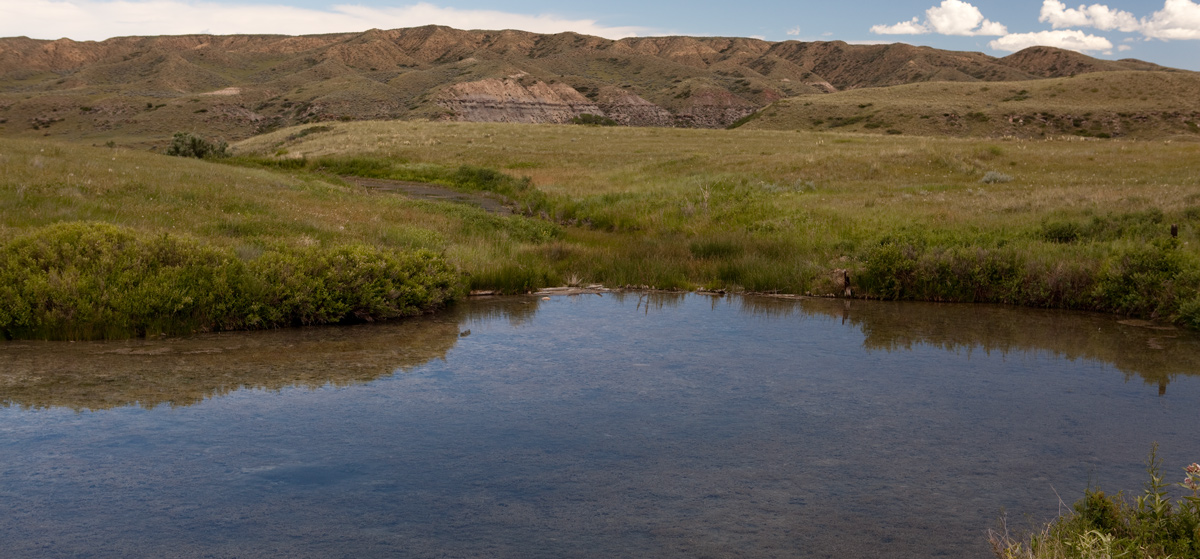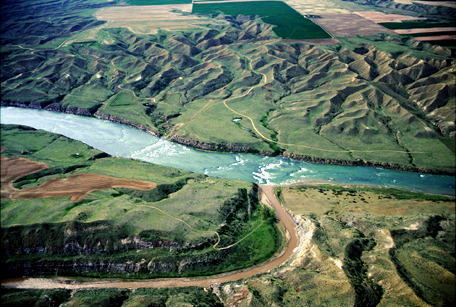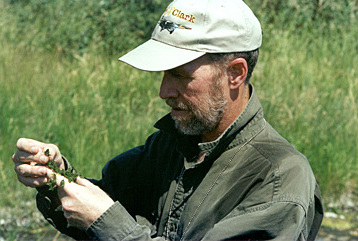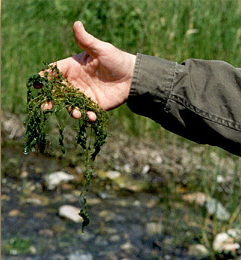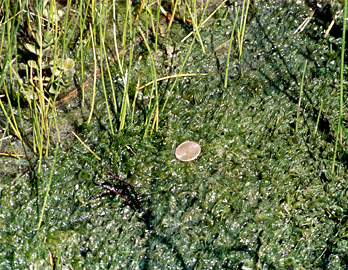Sulphur Springs
(view south)
© 2013 by Kristopher K. Townsend. Permission to use granted under the Creative Commons Attribution-Share Alike 4.0 International license.
Sacagawea Calls in Sick
At the mouth of the Marias River on June 10, 1805, just before setting out to explore the “Southerley” fork of the Missouri, Lewis noted, “Sah-cah-gah, we a, our Indian woman is very sick this evening: Capt. C. blead her.” Indeed, Clark’s concern for her was conspicuous in his daily journal entries, which described her serious condition and his repeated bleeding therapy.
Moving the expedition upstream on June 13th, Clark again commented, “the Indian woman Verry sick I gave her a doste of Salts.” On the fifteenth, Clark noted that Sacagawea was still “Sick & low Spirited,” so he “gave the bark & apply it exteranaly to her region.” By evening she was much worse and would not take any of the medicines he offered her.
On the sixteenth, returning to the party’s main camp after his triumphant discovery and exploration of the Great Falls of the Missouri, Lewis found that “she now lay gravely ill, delirious, and much reduced by her indisposition.” He gave her “two dozes of barks and opium,”[1]See Ronald V. Loge, M.D., ” ‘Two dozes of barks and opium’: Lewis and Clark as Physicians,” We Proceeded On, Vol. 23, No. 1 (February 1997), 10-15, 30. Reprinted from The … Continue reading and soon noted an improvement in her pulse. He had his men cross the river “to procure the water of the Sulpher spring,” “the virtues of which,” Lewis asserted, “I now resolved to try on the Indian woman.” The men who obtained this water were said to “drink freely of it.”[2]Lewis’s spelling, “Sulpher”—he meant “sulphur”—is the British form of the word. The preferred spelling of the chemical by the International Union of Pure and Applied … Continue reading
Lewis may have recognized the smell and taste of this mineral spring because it reminded him of a medicinal spring back home in Virginia. Expecting a therapeutic benefit for Sacagawea, he “caused her to drink the mineral water altogether.” In addition, Captain Lewis continued Clark’s previous treatments of compresses of bark (Peruvian bark, or cinchona) over her lower abdomen, plus laudanum (tincture of opium) administered orally, and she seemed to improve.
Quick Recovery
Location of Sulphur Springs
To see labels, point to the image.
© 2001 Airphoto, Jim Wark. All rights reserved.
By 15 June 1805, Lewis had made several trips along the far side of the river, and undoubtedly had noticed the strong, familiar odor as he passed the little pothole, for he named it “Sulpher spring.” Chemists later would identify the odor as that of hydrogen sulfide, which is produced by the decay of anaerobic bacteria in standing water. “The spring,” Lewis wrote that day:
is situated about 200 yards from the Missouri on the N.E. side, nearly opposite to the entrance of a large creek; it discharges itself into the Missouri over a precepice of rock about 25 feet, forming a pretty little cataract. The water is as transparent as possible, strongly impregnated with sulpher, and I suspect Iron also, as the colour of the hills and bluffs in the neighbourhood indicate the existence of that metal. The water to all appearance is precisely similar to that of Bowyer’s spring in Virginia.
The following day Lewis continued the same treatment course, and Sacagawea became free of fever and was at last able to eat some buffalo soup. With ongoing therapy she seemed to recover quickly until the 19th when she had a brief relapse. This time Lewis induced a therapeutic sweat with dilute potassium nitrate and relieved her pain with more laudanum. In a few days she was taking part in the difficult portage around the falls. Her illness was not mentioned in the journals again.
In considering Sacagawea’s illness and the Captains’ treatments, four questions arise: 1) What was the exact nature of her illness? 2) What minerals were in the Sulphur Springs water? 3) Did Lewis correctly anticipate the medicinal effect of the water? 4) Did the mineral water cure her illness?
There is general agreement by most who have analyzed Sacagawea’s illness, which was manifested by prominent pelvic pain, fever, anorexia and delirium, that these symptoms represented an illness now known as pelvic inflammatory disease, or PID, an infection of the ovaries and fallopian tubes caused by a sexually transmitted agent such as gonorrhea or chlamydia. This is one illness known in the pre-antibiotic era from which a woman could recover spontaneously. Because it typically causes either temporary or permanent infertility, this might explain why it was several years until Sacagawea is believed to have borne another child–an unusual hiatus for an otherwise healthy young woman.
Chemical Analysis
What medicinal value or effect did the Sulphur Springs waters have, if any? Many have confused sulfur with the word “sulfa,” and have attributed an antibiotic effect of the Sulphur Springs water, thereby postulating that the water cured her serious infection. Actually, the sulfurous smell of these types of waters comes from hydrogen sulfide gas. Even extremely small amounts of this gas impart its distinctive odor. However, there is no relationship between hydrogen sulfide or dissolved sulfate salts and sulfa antibiotics nor is there intrinsic antimicrobial effect of the water when taken internally. Neither could vegetation byproducts nor algae have effected a cure.
Eldon G. Chuinard,[3]Eldon G. Chuinard, Only One Man Died: The Medical Aspects of the Lewis and Clark Expedition (Glendale, California: Arthur H. Clark, 1979), p. 137. Steven Ambrose,[4]Stephen E. Ambrose, Undaunted Courage: Meriwether Lewis, Thomas Jefferson, and the Opening of the American West (New York: Simon & Schuster, 1996), pp. 241-242. and most recently David Peck[5]David Peck, D.O., Or Perish in the Attempt: Wilderness Medicine in the Lewis & Clark Expedition (Helena, Montana: Farcountry Press, 2002), p. 161. and Bruce Paton[6]Bruce C. Paton, M.D., Lewis & Clark: Doctors in the Wilderness (Golden, Colorado: Fulcrum Publishing, 2001), p. 132. have more or less subscribed to the theory that the dissolved minerals in this water restored blood electrolytes, which had been depleted by the length and severity of Sacagawea’s illness. This would be today’s equivalent of the use of intravenous salt solutions or oral Gatorade-like solutions for patients with severe fluid loss from any cause.
This restorative hypothesis has one major weakness. To be effective as oral rehydration agents, Gatorade-like fluids are dependent on a proper balance of minerals and glucose, often in a one-to-one ratio. High concentrations of sugar are necessary for the gut to absorb both the water and the electrolytes. Without sugar the fluids and minerals are absorbed only minimally and are ineffective in correcting dehydration. Mineral spring waters lacking sugar are not equivalents of known effective oral repletive therapies.
Analyses of the Sulphur Springs water made in 1932 and 1997 give us some insight into what effect the water may have had on Sacagawea. The 1997 analysis reported by Dr. Robert Bergantino, of the Montana Bureau of Mines and Geology, revealed the following mineral content, and compared it with a commercial mineral water:
| Chemical | sulphur Spring[7]Average of 1932 and 1997 analyses. | Perrier! |
|---|---|---|
| Calcium | 202[8]Values are in milligrams per liter. | 152 |
| Magnesium | 130 | 4 |
| Sodium | 126 | 10 |
| Potassium | 10 | 0.6 |
| Iron | 0.06 | 0 |
| Silica | 12 | 0 |
| Bicarbonate | 204 | 207 |
| Chloride | 32 | 26 |
| Sulphate | 890 | 38 |
| Nitrate | 0.5 | 5 |
| pH | 6.5 | 5.5 |
As can be seen in the chemical analysis of the water, there is no sulfur in Sulphur Springs. Sulfate (SO4) is an odorless and tasteless compound. But Lewis was right about the presence of iron in the soil thereabouts. There is enough oxidized iron in the water of Portage Creek that they also called it “Red Creek.” In Sulphur Springs, however, there is only six one-hundredths of a milligram of iron, which is insufficient to impart more than a slightly alkaline taste.
The location of Bowyer’s spring Lewis uses for comparison is unknown today, but “medicinal springs” were popular everywhere. Thomas Jefferson listed a few of them in his Notes on the State of Virginia, remarking that some of them were “indubitably efficacious, while others seem to owe their reputation as much to fancy and change of air and regimen, as to their real virtues.” Openly skeptical of modern medicine, he pointed out that none of the waters had been subjected to chemical analysis, “nor been so far the subject of observations as to have produced a reduction into classes of the disorders which they relieve.”[9]Thomas Jefferson, Notes on the State of Virginia, ed. William Peden (Chapel Hill: University of North Carolina Press, 1955), 34.
Lewis should have said the spring was on the northwest side of the river, since at this point the Missouri is flowing generally northeast. The aerial view above is due westward. The fields on the prairie beyond the breaks are laid out along section lines, which always run north-south and east-west. The field above center is dark green with rising winter wheat. The light-brown fields are fallow; the dark brown ones have been freshly ploughed. Farmers’ access lanes snake down the draws.
After the rest of the Corps arrived at the place Clark selected as the lower portage camp, on this side of the river (see photo), Lewis remarked that one of the small canoes was left below the rapid opposite the mouth of Portage Creek “in order to pass and repass the river for the purpose of hunting as well as to procure the water of the Sulpher spring, the virtues of which I now resolved to try on the Indian woman.”
Medicinal Qualities
Richard McCourt examines a specimen of Chara vulgaris
Sulphur Springs, near Great Falls, Montana
© 2002 VIAs Inc.
Dr. McCourt is Associate Curator of Botany at the Academy of Natural Sciences in Philadelphia, Pennsylvania. Phycology is his principal field of interest.[10]The study of algae is called phycology, from phykos, the Greek word for seaweed.
What do those figures in the previous table mean? Compare the predominant minerals of Sulphur Springs with a common mineral water. Calcium and bicarbonate are both present. Bicarbonate gives mineral water effervescence, and combined with calcium it may neutralize stomach-acid to some extent. But notice the high content of magnesium, sodium, and especially sulfate in Sulphur Springs water. Sodium sulfate, also known as Glauber’s Salts, is a laxative, and in fact was in the expedition’s medicine chest. Epsom Salts, also a mild purgative, is magnesium sulfate. Sulfate salts, unlike gaseous hydrogen sulfide, are odorless.
Sulphur Springs’ mineral content, and its lack of sugar, not only makes it poorly absorbable by the gut but also makes it capable of inducing diarrhea if taken in ample quantities. But if diarrhea is the effect of a dose of this particular mineral water, why would Lewis treat his very ill, dehydrated patient with a purgative, which would cause further fluid losses?
The answer to this question is a key to understanding why Lewis referred to “the virtues” of the water he “resolved to try on the Indian woman.” His selection of therapy was not a random choice. He certainly was not aware of the physiologic derangements of dehydration, infection or shock, all concepts that awaited scores of years to be tested and understood. Rather, Lewis accepted the rudiments of contemporary theories of medicine. In that era it was believed illnesses were caused by inflammatory substances in the body. Treatments were directed at ridding the body of these morbid substances. Commonly used depletive therapies included bleeding, vomiting, bowel purging, blistering and sweating.
Prior to the administration of the Sulphur Springs water, Clark had already bled Sacagawea three times, sweated her with potassium nitrate, treated her fever with Peruvian barks, and purged her system with a “dose of Salts.”
At the time of a serious illness, Lewis’s turning to a potential gentle purgative effect of natural Sulphur Springs water was entirely consistent with accepted understanding of diseases and treatments. It also demonstrated his resourcefulness. He was personally familiar with the laxative effects of mineral salts and often took a dose of his favorite remedy, Glauber’s salts, when beset by abdominal discomfort or diarrhea.
If, at best, the Sulphur Springs water had only a mild laxative effect, then what cured Sacagawea? More than likely, her recovery was not due to any of the treatments administered by the captains, including the water from Sulphur Sprin. Ironically, Sacagawea’s ingestion of Sulphur Springs water merely coincided with her own immune system’s ultimate clearing of the self-limited infection. As anticlimactic as this explanation seems, the episode demonstrates a recurring theme in the medical care the captains gave the members of the Corps of Discovery. They used very pragmatic approaches based on what they understood about illnesses, and their patients seemed to recover afterwards. It is a tribute more to the robustness of Sacagawea and the men of the Corps than to the medicines the Captains dispensed.
The Sulfur Smell
The smell of the spring that caught Lewis’s attention comes from hydrogen sulfide created by decaying anaerobic bacteria at the bottom of the pond.[11]Some say hydrogen sulfide smells like rotten eggs, implying that rotten eggs smell like hydrogen sulfide. But anyone who has raised chickens the “natural way,” and has had to locate a … Continue reading But there is another odor in the neighborhood—at least distinctive, some say obnoxious, and decidedly unappetizing—that is peculiar to a species of algae growing there today, called Chara vulgaris Linneaus.[12]In Lewis’s day the term alga (plural, algae) was not yet in any dictionary, for seaweed and similar “marine productions,” as Lewis called them, were still considered to be related … Continue readingFor instance, charaphytes have large cells that are studied by biologists interested in how cells maintain their interior water pressure. It is one of the most widespread members of the genus, which accounts for the name of the species, vulgaris, meaning “common.”[13]More information about the fascinating world of Charophyta may be read on the Web site for the Algal Collection of the U.S. National Herbarium, of the Smithsonian Institution, … Continue reading
In 1813 the Reverend Henry Muhlenberg (1753-1815), a German-American botanist and Lutheran pastor, published his Catalogus plantarum Americae septentrionalis (Catalogue of North American Plants) in Lancaster, Pennsylvania (second ed., 1818). It contained over 700 species of algae, lichens, fungi and mosses that he had collected within a three-mile radius of his parish in Lancaster.
It thrives in water hardened, as this is, by flowing through limestone. Dr. McCourt’s colleague, Ken Karol, positively identified the specimen pictured at left, by sequencing a gene in its chloroplast.[14]A chloroplast is the structure of genes within a cell where photosynthesis occurs. Gene sequencing is a method of studying molecular structure of a gene by determining the arrangement, or sequence, … Continue reading
Here at Sulphur Springs today, it is easy to overlook—”over-smell”?—the intrinsic beauty of a charaphyte. In this setting, remote from the modern urban monotony of gasoline or diesel fumes and the fat smell of hot grease, which suffuse our otherwise sanitized and deodorized days, the odor of Chara vulgaris is unique, and is so conspicuous that one may wonder why none of the journalists mentioned it. They might simply have ignored it, of course, given the variety and richness of the olfactory environments they passed through day by day. Besides, it couldn’t have been as much of a turnoff as the stink of decaying bison carcasses they had to wade around in the Missouri River below the Falls.
Perhaps it’s just as well we don’t have scratch-and-sniff utilities on the World Wide Web—yet.
Something More
Another Consideration or Two
We saw a herd of buffaloe come down to water at the sulpher spring this evening,” Lewis recorded on the eighteenth of June, 1805. “I dispatched some hunters to kill some of them, and a man also for a cask of mineral water.”
Sulphur Springs
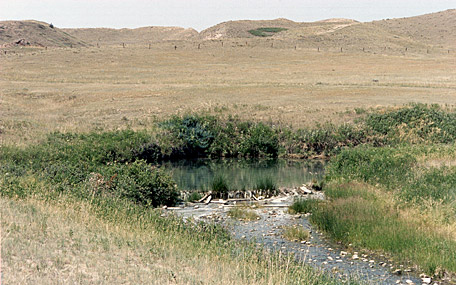
© 2002 VIAs Inc.
The vegetation on the banks today might not have been present when Lewis passed by. The trampling of buffalo herds watering at the hole would have kept it from growing as thickly as it appears above, if at all. The bison, of course, would have contributed one or two more odors to the mix.
Although I agree overall with Dr. Loge’s fine commentary on the benefits and the medicinal value of the Sulphur Springs waters that were administered to Sacagawea during her severe illness near the Great Falls of the Missouri, I would like to express my position on this issue.
Any possible benefit derived by Sacagawea from the Sulphur Springs water certainly was not equivalent to any modern electrolytic oral rehydration fluids such as Pedialyte or Gatorade, or intravenous salt solutions. As I have pointed out elsewhere,[15]Peck, 161. there were “possible benefits” from the minerals contained in the water. I believe these effects were minimal at best. I wrote this statement to avoid laboring over some complex intestinal physiology, which I did not feel was appropriate for my book.
The absorption of water in the small intestine is absolutely dependent on absorption of minerals (electrolytes), in particular, sodium. The absorption of glucose (products of carbohydrate digestion) or amino acids (products of protein digestion) is also dependent on a sodium-driven electrochemical gradient between cells lining the small intestine and the food solution inside the intestine.
Absorption of potassium from the diet is passive and does not require any specific transport mechanism. If there is a more concentrated potassium concentration inside the intestinal food solution, there will be movement of this mineral from inside the intestine into the body’s circulation.
There is also “nutrient-independent” transport of some electrolytes in the distal large intestine. In people suffering from some diarrheas, if they become severely salt-depleted, a hormone from the adrenal glands (aldosterone) can increase sodium (and chloride) absorption in the distal colon.[16]A deficiency of aldosterone hormone from the adrenal glands results in Addison’s disease, with which President Kennedy was afflicted. This in turn can encourage more water absorption at these sites as well. In general, the large intestine is more able to reabsorb water into the body than the small intestine.
Electrolyte absorption in the intestines is, without question, best accomplished in the presence of amino acids and sugars in the diet, as Dr. Loge has noted. The mineral water administered to Sacagawea makes a more interesting story from the expedition than it did as an effective medicinal or rehydration solution. However, there may have been a slight beneficial effect.
Experience the Lewis and Clark Trail
The Lewis and Clark Trail Experience—our sister site at lewisandclark.travel—connects the world to people and places on the Lewis and Clark Trail.
Plan a trip related to Sulphur Springs:

The Great Falls Lower Portage is a High Potential Historic Site along the Lewis and Clark National Historic Trail managed by the U.S. National Park Service. It includes Sulphur Springs (open to the public) and Lower Portage camp site (private land).—ed.
Notes
| ↑1 | See Ronald V. Loge, M.D., ” ‘Two dozes of barks and opium’: Lewis and Clark as Physicians,” We Proceeded On, Vol. 23, No. 1 (February 1997), 10-15, 30. Reprinted from The Pharos of Alpha Omega Alpha, Vol. 59, No. 3 (Summer, 1996), 26-31. |
|---|---|
| ↑2 | Lewis’s spelling, “Sulpher”—he meant “sulphur”—is the British form of the word. The preferred spelling of the chemical by the International Union of Pure and Applied Chemistry is sulfur. |
| ↑3 | Eldon G. Chuinard, Only One Man Died: The Medical Aspects of the Lewis and Clark Expedition (Glendale, California: Arthur H. Clark, 1979), p. 137. |
| ↑4 | Stephen E. Ambrose, Undaunted Courage: Meriwether Lewis, Thomas Jefferson, and the Opening of the American West (New York: Simon & Schuster, 1996), pp. 241-242. |
| ↑5 | David Peck, D.O., Or Perish in the Attempt: Wilderness Medicine in the Lewis & Clark Expedition (Helena, Montana: Farcountry Press, 2002), p. 161. |
| ↑6 | Bruce C. Paton, M.D., Lewis & Clark: Doctors in the Wilderness (Golden, Colorado: Fulcrum Publishing, 2001), p. 132. |
| ↑7 | Average of 1932 and 1997 analyses. |
| ↑8 | Values are in milligrams per liter. |
| ↑9 | Thomas Jefferson, Notes on the State of Virginia, ed. William Peden (Chapel Hill: University of North Carolina Press, 1955), 34. |
| ↑10 | The study of algae is called phycology, from phykos, the Greek word for seaweed. |
| ↑11 | Some say hydrogen sulfide smells like rotten eggs, implying that rotten eggs smell like hydrogen sulfide. But anyone who has raised chickens the “natural way,” and has had to locate a long-lost egg among the beds of henhouse straw, is entitled to question that. And anyone who has scrambled a too-well-hidden Easter egg with a weed-eater in mid-August definitely will not think of hydrogen sulfide, but of the quickest path to a shovel with a—as Clark would have spelled it—verry long handle. |
| ↑12 | In Lewis’s day the term alga (plural, algae) was not yet in any dictionary, for seaweed and similar “marine productions,” as Lewis called them, were still considered to be related to terrestrial plants. In the 1830s, however, scientists began to discover that marine algae lack functional roots, stems, leaves, and plant-like reproductive systems, but instead represent a unique and extremely complex group of photosynthetic organisms. It remained for later investigators to grasp the far-reaching ecological significance of the biotic kingdom that was given the name Protista in 1866, but which attracted relatively little attention until a century later. Phycology, as the study of algae is called, remains one of the most challenging frontiers of the scientific community. For an account of a recent discovery by Dr. McCourt relating to a certain species of algae in the evolution of plant life on earth, see the News Department of the Biodiversity Research Group at the Academy of Natural Sciences, http://www.acnatsci.org/press/plantevolution.html/ |
| ↑13 | More information about the fascinating world of Charophyta may be read on the Web site for the Algal Collection of the U.S. National Herbarium, of the Smithsonian Institution, http://botany.si.edu/projects/algae/ |
| ↑14 | A chloroplast is the structure of genes within a cell where photosynthesis occurs. Gene sequencing is a method of studying molecular structure of a gene by determining the arrangement, or sequence, of its components. |
| ↑15 | Peck, 161. |
| ↑16 | A deficiency of aldosterone hormone from the adrenal glands results in Addison’s disease, with which President Kennedy was afflicted. |
